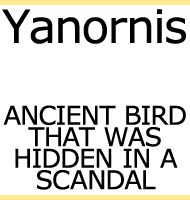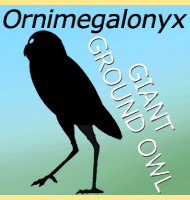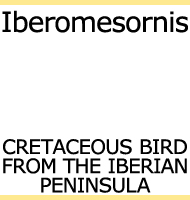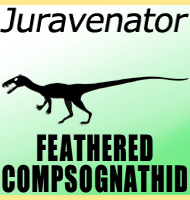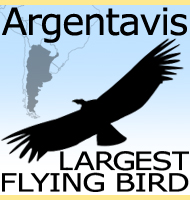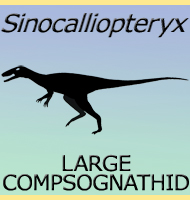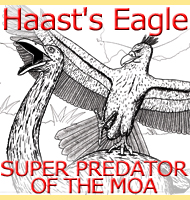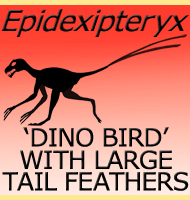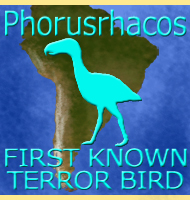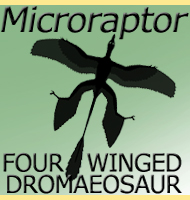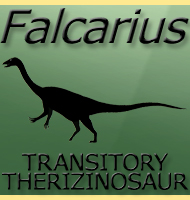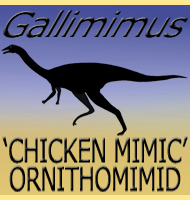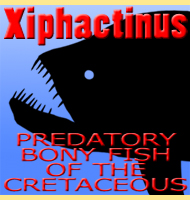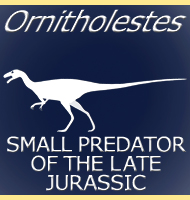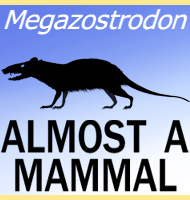


Confuciusornis
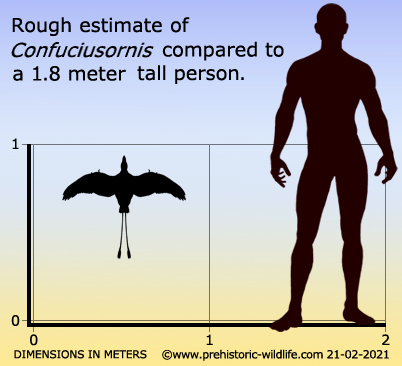
Name:
Confuciusornis
(Confucius bird).
Phonetic: Kon-few-shus-or-nis.
Named By: Zhou Zhonge, Hu Yoaming, Hou Lianhai
& Gu Youcai - 1995.
Synonyms: Confuciusornis chuonzhous,
Confuciusornis suniae. Possibly Jinzhouornis.
Classification: Chordata, Aves, Avebrevicauda,
Pygostylia, Confuciusornithiformes, Confuciusornithidae.
Species: C. sanctus
(type), C. dui, C. feducciai, C.
jianchangensis, C. shifan.
Diet: Uncertain but probably at least partially
piscivorous. See main text.
Size: Wingspan about 70 centimetres.
Known locations: China - Yixian Formation
& Jiufotang Formation.
Time period: Barremian/Aptian of the Cretaceous.
Fossil representation: Remains of literally hundreds
of individuals, many complete with feather detail preservation.
Confuciusornis
is a genus of early bird that lived in China during the early
Cretaceous. The interesting thing about the genus though is that even
though it is clearly a primitive bird, it just doesn’t seem to quite
fit within the established evolutionary transition of birds.
The
first birds appeared at least as far back as the Tithonian of the
Jurassic roughly around twenty to twenty-seven million years before the
known appearance of Confuciusornis in the fossil
record. The obvious
reference here is the appearance of Archaeopteryx
in what would become
Europe, and although a new genus of primitive bird may one day be
discovered to have lived before Archaeopteryx, Archaeopteryx
is the
genus that is still currently used to compare other primitive birds
to, partially at least because of the wealth of study that has been
devoted to Archaeopteryx.
The
most primitive birds were recently descended from theropod dinosaurs,
and they still had long thin theropod-like tails, a feature that
is firmly established as present in Archaeopteryx.
In Confuciusornis
the tail has already disappeared and has been replaced by a pygostyle
like those of modern birds. The pygostyle in modern forms is where
the flight tail feathers that control steering and drag during flight
are attached to the body, but even though Confuciusornis
had a
pygostyle, no tail flight feathers were present.
Instead
of flight feathers, the pygostyle had a covering of more simply downy
contour feathers. There were however two exceptionally long feathers
that trailed behind the body in some specimens. These have been
described to have been more like ribbons in that they were only
reinforced with a central spine at the ends rather than the full length
of the feather. Because these two feathers are only known in some
specimens, they have been speculated to have been display features
that were used by the males to attract females.
Although
living during the early Cretaceous, Confuciusornis
already had well
developed flight feathers on the wing, and with the longest measuring
up to 207 millimetres in length, Confuciusornis
had some of the
proportionately longest flight feathers relative to body size known for
any bird, including modern forms. In 2010 a study led by Zhang
Fucheng et al, investigated the colouration of Confuciusornis
feathers by scanning them under an electron microscope and searching
for the melanosomes. During their search, Confuciusornis
specimen
IVPP 13171 yielded melanosomes that indicated colours of grey,
black and either red or brown.
The
colours for Confuciusornis certainly fall within
the known spectrum for
early bird and dinosaur colours. Archaeopteryx is
known to have had
some black feathers on the wings, and the feathered dinosaur
Sinosauropteryx
is known to have had an alternating pattern of brown
and white bands that ran down the length of the tail. Best known so
far is Anchiornis
which has been confirmed to have been black all over
with white streaks down the wings, red speckling on the face and an
orange feathered crest on top of the head.
At
first glance the wings of Confuciusornis seem to be
very well adapted
for flight, they are certainly among the longest wings relative to
body size so far known in primitive birds. The humerus (equivalent
to your upper arm bone) is long and has a large opening that not only
reduced weight, but may have allowed for the attachment of larger and
hence more powerful muscles. The second and third metacarpals
(equivalent to your hand bones) were partially fused, while the
second metacarpal was also more heavily built for supporting the flight
feathers. The fingers on Confuciusornis could
still move
independently from one another, and claws grew from the ends. The
claw of the first digit was also larger than the claws of the second
and third digits.
One
feature of modern birds that was lacking in Confuciusornis
was the
alula, more commonly referred to as the ‘bastard wing'. The
alula is essentially a small extension of the wing that projects from
the front (anterior) edge. The alula is formed by the growth of
several flight feathers that are anchored to the first digit. In
normal forward flight the alula folds along the edge of the wing, but
when slower speeds are required, such as when landing, the alula is
extended to provide additional lift so that the bird does not stall in
the air and fall to the ground.
The
lack of an alula indicates that Confuciusornis were
not agile slow
speed fliers, and probably could not slow themselves down all that
much for landing. This might explain the reason for having possibly
more powerful muscles as these might have allowed the wings to absorb
some of the impact of landing. This may have been a case of flying
from tree trunk to tree trunk since the claws of the fingers,
particularly the first would have been an additional aid in gripping
the trunks.
There
is little doubt that Confuciusornis could fly,
but how well remains a
matter of strong debate. The wings and flight feathers on them were
easily capable of providing lift, but the real question is could
Confuciusornis go beyond gliding and use these wings
for powered
flapping flight? Gliding is easy to establish, and many consider
gliding habits either for moving through a habitat or predator escape
to be the precursor to flapping flight. To look at the possibility of
flapping flight, the wings are important but you must also think
about the rest of the skeleton.
One
key development that allows for flapping flight is the ability to
perform an efficient flight stroke, a motion of wing movement that
allows the wings to lift the body into the air and keep it there.
Modern birds have shoulders aligned dorsally and angled slightly
upwards to the back so that the wings can arc up above the back for a
stronger flight stroke. In Confuciusornis however
the shoulders
attach further down and have a sideways orientation that likely
prevented them from lifting above the head.
Flapping
wings also need powerful muscles, but not so much in the wings
themselves but across the chest. Analogous to your own pectoral
muscles, these muscles provide the bulk of the power for flapping
flight and are exactly why birds have deep, round chests. These
muscles however need strong attachment points to connect them to the
skeleton. This is usually a sternum (breast bone) that has a
developed bony keel to provide a larger surface area for muscle
attachment. In Confuciusornis the keel was
present, but is not seen
to have been as well developed as the keels of modern bird forms,
something that counts against the ability for Confuciusornis
to be a
strong powered flyer. Often in modern birds the bony keel is further
extended by a cartilaginous addition, something that you can see for
yourself when you carve up a chicken. Cartilage does not tend to
fossilise because it is still soft tissue that usually decays before it
can be fossilised, though impressions of cartilage can sometimes be
preserved. However, despite the hundreds of Confuciusornis
specimens so far discovered, an impression of a cartilaginous keel
has yet to be positively identified.
Sharing
some of the same problems as Archaeopteryx, Confuciusornis
does not
seem to have had entirely the necessary requirements to rely upon
flapping flight. The lack of flight feathers on the tail as well as
the lack of an alula also indicate that when in the air,
Confuciusornis would not have had anything like the
manoeuvrability of
modern birds, and in this respect these could be further arguments
against powered flight. But just maybe we should not be so concerned
about comparing primitive forms to modern birds.
Confuciusornis
was a primitive bird, always was and will be, so it would be
foolhardy to say it could not do certain things just because it lacked
some features that modern birds use thanks to an additional one hundred
and twenty million years of evolution. One key fact to consider is
that Confuciusornis is known by hundreds of
specimens, and the
overwhelming majority of these were preserved in lake sediments. This
of course leads to another question, if Confuciusornis
couldn’t fly,
then how did so many end up at the bottom of a lake? The areas where
Confuciusornis are known from are known to have
been geologically
active (volcanoes, earthquakes, etc) and it has been proposed
more than once that the accumulation of so many Confuciusornis
at the
bottom of a lake could have been the result of flocks of Confuciusornis
getting caught in sudden releases of volcanic gases and/or ash as they
flew over the lake.
An
additional thing to think about is that because lakes are large open
bodies of water they tend to lack features that can slow down wind,
meaning stronger gusts of air over the water surface. You can feel
this effect for yourself just by walking next to a large body of water
whether it is a natural lake, reservoir or water filled gravel pit.
If Confuciusornis frequented lakeside environments
then they may have
had a third option; soaring. Like gliding, soaring does not
require that much wing movement beyond fairly minor adjustments to take
advantage of wind currents, and beyond the initial lift into the
air, flapping may not have even been required. The lack of tail
flight feathers would have course been a hindrance to fine flight
control, but maybe Confuciusornis relied more
upon the actual wings
for steering. This would also explain the possible presence of
stronger muscles within the wings themselves as they would compensate
for a lack of tail. This would be analogous to flying an aeroplane
just by the ailerons of the wings rather than the elevons and rudder of
the tail as well.
Another
area of confusion is that Confuciusornis had a
toothless beak.
Compared to modern birds this is not that unusual at all, but some
Cretaceous era birds such as Ichthyornis
and Hesperornis
which lived
much later than Confuciusornis are known to still
have strongly
developed teeth. However, Ichthyornis and Hesperornis
are probably
not good examples to compare Confuciusornis too as
both of these genera
were sea birds and piscivores (fish eaters), and the teeth would
have been a useful adaptation in spearing the bodies of fish. With
that said though, modern fish eating birds have toothless beaks as
well, though some such as Mergus merganser
(also known as the
Goosander and Common Merganser) have a serrated edge to their beaks.
The
loss of teeth in Confuciusornis could just be down
to a feeding
specialisation or even a generalisation, and that forms such as
Ichthyornis and Hesperornis
retained their teeth later simply because
they fitted their feeding lifestyle better. The exact diet of
Confuciusornis is unknown, but a bolus of fish
bones believed to have
been from the genus Jinanichthys
have been found as what could be
stomach remains of a specimen of Confuciusornis
(IVPP V13313).
This would indicate that Confuciusornis could take
and consume small
fish, and coupled with the occurrence of so many Confuciusornis
specimens in connection with lake sediments, it seems that piscivory
is highly likely in Confuciusornis. This does not
necessarily mean
that Confuciusornis were exclusive piscivores
however as there are a
few modern birds such as Tanysiptera (paradise
kingfisher) which
are known to eat fish, but will also hunt for other creatures too.
On an additional note, Tanysiptera also have
tail plumes similar to
those of Confuciusornis.
While
Confuciusornis is one of the first birds known to
have had a beak,
the beak itself was still quite primitive. Aside from being heavily
built, the upper beak was also incapable of moving, while in modern
birds the snout can move slightly so that the mouth can be opened
wider. The beaks of Confuciusornis can illustrate
a stage of how
beaks not only came to be formed, but a stage in the development of
this feature. The development of beaks and toothlessness is not
exclusive to birds however, some groups of theropod dinosaurs are
also known to have developed beaks, with the oviraptosaurs
being the
best known group. The ornithomimosaurs
and the therizinosaurs
are two
more examples of theropod dinosaurs that became toothless with time.
Rather
than having a firm placement in the on-going evolution of birds,
Confuciusornis might represent an evolutionary
offshoot that developed
some features that were similar to later birds, but otherwise did not
have any descendants that went anywhere with them. This would at
least explain the mix of primitive and modern features that appeared
before they became standardised in later forms. Here the driving
force would have been convergent evolution, where an organism
adapts to a specific set of survival parameters that other unrelated
creatures also have to live to, hence the appearance of similar
adaptations. The concept of ‘evolutionary dead ends’ is well
known, and if true, then Confuciusornis would
not be the only
example of an evolutionary off shoot that just didn’t go anywhere.
Further reading
- Confuciusornis sanctus, a new Late Jurassic
sauriurine bird from
China - L. Hou, Z. Zhou, Y. Gu, H. Zhang - 1995.
- The discovery of Early Cretaceous birds in China - Z. Zhou
- 1995.
- Confuciusornis sanctus compared to Archaeopteryx
lithographica -
L. D. Martin, Z. Zhou, L. Hou & A. Feduccia
-
1998.
- Osteological microstructure of Confuciusornis:
preliminary
report - F. Zhang, L. Hou & L. Ouyang - 1998.
- Confuciusornis and the early evolution of
birds - Z. Zhou
& L. Hou - 1998.
- Some microstructure difference among Confuciusornis,
Alligator
and a small theropod dinosaur, and its implications - F. -C.
Zhang, X. Xu & J. L� - 1999.
- A diapsid skull in a new species of the primitive bird
Confuciusornis - L. Hou, L. D. Martin,
Z. Zhou, A.
Feduccia & F. Zhang - 1999.
- Anatomy and systematics of the Confuciusornithidae (Theropoda: Aves)
from the late Mesozoic of northeastern China - Luis M. Chiappe, Ji
Shu-An. Ji Qiang & Mark A. Norell - 1999.
- Taphonomy and mass mortality of Confuciusornis
and feathered
dinosaurs
at the Sihetun and Zhangjiagou sites in western Liaoning, China - X.
Wang, F. Zhang, X. Xu, Y. Wang & G.Gu - 2000.
- New advances in the study of the primitive bird Confuciusornis
-
Q. Ji - 2001.
- ‘Flight capability and habits of Confuciusornis’.
In:
Gauthier and Gall (eds). New perspectives on the origin and
early evolution of birds: proceedings of the international symposium
in honor of John H. Ostrom - Z. Zhou & J. O.
Farlow
- 2001.
- Biology of basal birds and the origin of avian flight". In:
Zhou Z., Zhang F. (eds) - A. Elzanowski - 2002.
- Osteohistology of Confuciusornis sanctus
(Theropoda: Aves) -
A. J. De Ricql�s, K. Padian, J. R. Horner, E. T.
Alamm & N. Myhrvold - 2003.
- Development and evolution of avian racket plumes: Fine structure
and serial homology of the wire - Robert Bleiwess - 2005.
- Non-Avian dinosaur fossils from the Lower Cretaceous Jehol Group of
western Liaoning, China - X. Xu & M. A. Norell
-
2006.
- Life history of a basal bird: morphometrics of the Early
Cretaceous Confuciusornis - L. M. Chiappe,
J.
Marugan-Lobon, S. Ji & Z. Zhou - 2008.
- Diversification in an Early Cretaceous avian genus: evidence from
a new species of Confuciusornis from China -
Z. Zhang, C.
Gao, Q. Meng, J. Liu, L. Hou & G. Zheng -
2009.
- An attempt to reconstruct the lifestyle of confuciusornithids
(Aves, Confuciusornithiformes) - A. V. Zinoviev - 2009.
- Life history, sexual dimorphism and ‘ornamental’ feathers in
the mesozoic bird Confuciusornis sanctus -
Winfried S. Peters
& Dieter Stefan Peters - 2009.
- Fossilized melanosomes and the colour of Cretaceous dinosaurs and
birds - Fucheng Zhang, Stuart L. Kearns, Patrick J. Orr,
Michael J. Benton, Zhonghe Zhou, Diane Johnson, Xing Xu
&
Xiaolin Wang - 2010.
- [A new species of Confuciusornis from Lower
Cretaceous of
Jianchung, Liaoning, China] - L. Li, J.-Q. Wang
&
S.-L. Hou - 2010.
- Narrow primary feather rachises in Confuciusornis
and Archaeopteryx
suggest poor flight ability - R. L. Nudds & G. J
Dyke
- 2010.
- Comment on 'Narrow Primary Feather Rachises in Confuciusornis
and
Archaeopteryx Suggest Poor Flight Ability - Gregory S. Paul -
2010.
- Basal birds from China: a brief review - D. Li, C.
Sulliven, Z. Zhou & Z. Zhang - 2010.
- Comment on “Narrow Primary Feather Rachises in Confuciusornis
and
Archaeopteryx Suggest Poor Flight Ability - Xiaoting Zheng, Xing
Xu, Zhonghe Zhou, Desui Miao & Fucheng Zhang - 2010.
- Response to comments on “Narrow Primary Feather Rachises in
Confuciusornis and Archaepteryx
Suggest Poor Flight Ability - R.
L. Nudds & G. Dyke - 2010.
- Nocturnality in Dinosaurs Inferred from Scleral Ring and Orbit
Morphology - L. Schmitz & R. Motani - 2011.
- Gender identification of the Mesozoic bird Confuciusornis
sanctus
- A. Chinsamy, L. M. Chiappe, J. S. Marug�n-Lob�n,
G. Chunling, Z. Fengjiao - 2013.
- Laser Fluorescence Illuminates the Soft Tissue and Life Habits of the
Early Cretaceous Bird Confuciusornis. - PLOS ONE. 11 (12). - A. R.
Falk, T. G. Kaye, Z. Zhou & D. A. Burnham - 2016.
- Elaborate plumage patterning in a Cretaceous bird. - PeerJ. 6. -
Quanguo Li, Julia A. Clarke, Ke-Qin Gao, Jennifer A. Peteya &
Matthew D. Shawkey - 2018.
-
A new confuciusornithid bird with a secondary epiphyseal ossification
reveals phylogenetic changes in confuciusornithid flight mode. -
Communications Biology. 5. 1398. - Renfei Wang, Dongyu Hu, Meisheng
Zhang, Shiying Wang, Qi Zhao, Corwin Sullivan & Xing Xu - 2022.
----------------------------------------------------------------------------
Random favourites
 |
 |
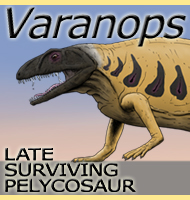 |
 |
